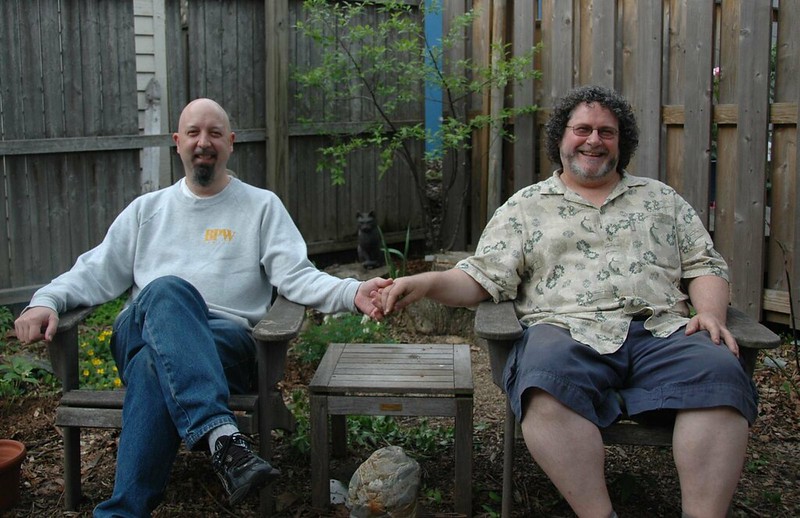Last week was NYC Wildflower Week. Appropriately, here are some wildflowers blooming over the past week in my backyard native plant garden.
Wildflowers blooming near the gardener’s nook in my backyard for last May’s Garden Blogging Bloom Day.

- Aquilegia canadensis, Eastern Columbine
- Chrysogonum virginianum ‘Allen Bush’, Green-and-Gold
- Dicentra eximia ‘Aurora’, White-flowering Eastern Bleeding-Heart, Turkey Corn
- Iris cristata, Crested Iris
- Phlox stolonifera
- Viola striata
- Zizia aurea, Golden Alexanders
- Brunnera macrophylla, Large-leaf Brunnera, Siberian Bugloss
Aquilegia canadensis, Eastern Red Columbine
Somehow, I have no photos of this from my garden in Flickr. Yet it’s been a favorite of mine for decades.
Native range is eastern North America. Widespread in New York state. Native to all five boroughs of NYC.
Aquilegia canadensis, Eastern Red Columbine, 2006-05-31
MOBOT
PLANTS
Chrysogonum virginianum ‘Allen Bush’, Green-and-Gold

A great groundcover for partial shade. Several cultivars are available. To my eye, all vary only slightly from the species, though I haven’t grown them side-by-side.
Individual flowers look like shaggy sunflowers.

Native range is Mid-Atlantic and Southeastern United States. Native to only one New York upstate county. Not native to NYC.
MOBOT
PLANTS
Dicentra eximia ‘Aurora’, Eastern Bleeding-Heart, Turkey Corn

A white-flowering cultivar of the native Eastern Bleeding Heart. Not every white-flowering form of a plant is successful. This is one that is equally lovely as the species, bringing its own graces to the structure of the inflorescence and individual flowers. Also a good choice for the shady white garden.
This plant is maybe three years old now. Not only has the original plant spread in size each year, this Spring I’ve noticed little seedlings cropping up around the mother plant. I’ll be curious to see how these develop, and what the flower color wil be in the children.
Dicentra eximia, Bleeding-heart, 2006-05-22
Dicentra eximia, Eastern bleeding-heart (Flickr photo set)
MOBOT
PLANTS
Iris cristata, Crested Iris

Really beautiful, if a bit of a finicky grower. It seems to be at its best when grown on a slight slope with ample mulch. The stems trail through the mulch, the fans oriented down-slope. Sulks during the summer. Needs consistent moisture during the hot summer months and good drainage during the winter or it will disappear. Where it’s happy, it makes a great groundcover.
Native to Mid-Atlantic and interior Eastern United States, but not New York.
MOBOT
PLANTS
Phlox stolonifera, Creeping Phlox

One of the best wildflower ground covers you can grow in the garden. In the trade, you’re more likely to find cultivars selected for flower color – such as ‘Bruce’s White’ and ‘Sherwood Purple’ – rather than the unqualified species. They all seem equally fine to me. (Mine is also a cultivar, but its name escapes me at the moment.) The flowers are usually fragrant, reminiscent of grape jelly.
Native range is most of Eastern United States, but only found in two upstate New York counties, not NYC.
MOBOT
PLANTS
Viola striata, Pale Violet, Striped Cream Violet

The “oldest” plant in this post, this population came from my second city garden on 5th Street in Park Slope. The original plants were given to me 8-10 years ago by a gay couple who lived across the street. They have a beautiful shady backyard garden growing many wildflowers collected from their home in upstate New York.
Native to Eastern North America. Native to several counties in New York, but not NYC.
MOBOT
PLANTS
Zizia aurea, Golden Alexanders

This plant is a recent discovery for me. I had never heard of it before picking it up from Gowanus Nursery last Spring. Now I see it all over the place, and it’s a fine groundcover. You can’t see it in this photo, but the foliage is also handsome.
Native to NYC, but not Brooklyn.
MOBOT
PLANTS
Brunnera macrophylla, Large-leaf Brunnera, Siberian Bugloss

Okay, Brunnera is not a native wildflower on this continent – it’s native range is Eastern Europe – but it is blooming in the backyard and it’s so pretty I had to take a picture of it. This plant is a refugee from the sideyard of Frank, a neighbor, professional gardener and fellow garden blogger at New York City Garden.
MOBOT
PLANTS
[bit.ly]
Related Content
Growing a Native Plant Garden in a Flatbush Backyard, August 6, 2007








































